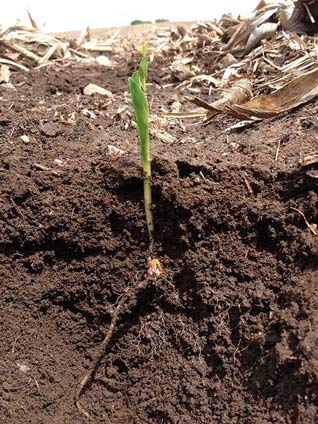By Eric Moore, ETS Agronomist
Uniform distribution of fertilizer is key for optimal crop performance. Consider the following points when planning your fertilizer application.
-
As you choose a strip-till method, be sure the fertilizer application method meets your requirements for fertilizer distribution.
-
Operate the machine at the correct speed and depth to ensure uniform incorporation.
-
Be sure the placement method does not leave a void in which nutrients get concentrated.
Limitations of Broadcasting and Banding Fertilizer
Broadcasting fertilizer requires mechanical incorporation across the entire field otherwise there can be nitrogen (N) losses to volatility from urea-based fertilizer sources or losses to wind or water. While this method creates a nutrient-rich zone a few inches below the soil surface, application can be non-uniform, and the loss of crop residue increases the soil erosion and concentration risk.
Banding fertilizer provides a higher concentration and greater efficiency than broadcasting. However, the band may be too high in salt content depending on the amount placed to meet crop removal rates. Additionally, there could be inconsistency throughout the soil profile as high concentrations in the band may be surrounded by low concentrations. In a banded system the seed may be placed in a no-fertility zone far outside the band or it may end up directly in a “hot” and unsafe band of fertilizer.
Incorporating nutrients throughout the zone reduces salt concentration thereby reducing toxicity to plants. This method allows a greater percentage of the root mass to be in contact with the nutrient-rich zone, and allows for higher application rates needed for today’s high yield environments. Ideally, these nutrients will be available to the plant throughout the growing season as the root mass grows.
Understanding the Salt Index
Salt index of a fertilizer is defined as a measure of the salt concentration of a fertilizer in the soil solution. Salt index is an important parameter to consider when comparing fertilizer product suitability for seed placement.
This University of Minnesota Extension article titled Banding Fertilizer with the Corn Seed is a great resource for determining the salt index of blended fertilizers. Table 6 shows the estimated range in maximum rates of fertilizers that can be applied on the corn seed while producing emergence and early growth similar to when no starter was applied.

This resource accounts for soil texture as well. In general for corn, the recommendation is to limit the amount of N and K20 in contact with the seed to no more than 10 pounds per acre.
Incorporating Nutrients Throughout the Zone
What does incorporating those nutrients throughout the “zone” created in a strip-till system do to those allowable safe nutrient levels?
The following example looks at the 100 pounds per acre of N applied in a band on 30-inch centers vs. incorporating that same 100 pounds per acre N in a 10-inc by 3-inch zone.
-
100 pounds per acre of N applied in a band on 30-inch centers would yield an N concentration of 12,400 parts per million.
-
That same 100 pounds per acre of N broadcast and incorporated to a 3-inch depth would yield a N concentration of 110 parts per million.
-
If that 100 pounds per acre of N were to be incorporated throughout the “zone” created in a strip-till system, the parts per million would essentially triple when compared to broadcast incorporation. (110 ppm N x 3 = 330 ppm N)

The result of this comparison would indicate that those nutrient concentrations in a band when placed uniformly throughout a tilled “zone” could result in a parts per million reduction of 97.34%
-
Based on these figures, if 10 pounds of N + K2O is the upper limit in a banded application on the seed, the upper limit when uniformly distributed in the strip-tilled “zone” would be closer to 375 pounds total N, K and S.
-
The key to this would be getting 100% uniform distribution, which is the goal but not always attainable.
Here are some considerations when looking at the different ways to create strip-till zones:
-
The dual coulter design of the SoilWarriorX row unit likely provides the most uniform distribution of nutrients throughout the tilled zone, vertically and horizontally.
-
A shank system can create a greater void or trench which could potentially create a concentrated “pocket” of dry fertilizer.
If you are using a shank-based system, I would recommend doing some experimentation in the field on the application point of the dry fertilizer. Angling the fertilizer distribution point a few inches rearward of a shank may help provide more uniform distribution.
A final consideration when comparing the risk of salt injury of banded starter fertilizers to fertilizers distributed throughout a strip-tilled zone is time. If good soil moisture is present when creating the zones, and some time is allowed to pass between the time of fertilizer application and crop planting, the risk of injury is reduced.
Courtesy of Iowa State University
Learn More
Banding vs. Broadcast: Nutrient Placement Benefits, Techniques & Management
Veteran strip-tillers share proven payback and lessons learned with targeted, timed nutrient applications.






